turn signal Oldsmobile Achieva 1998 s User Guide
[x] Cancel search | Manufacturer: OLDSMOBILE, Model Year: 1998, Model line: Achieva, Model: Oldsmobile Achieva 1998Pages: 356, PDF Size: 18.04 MB
Page 165 of 356
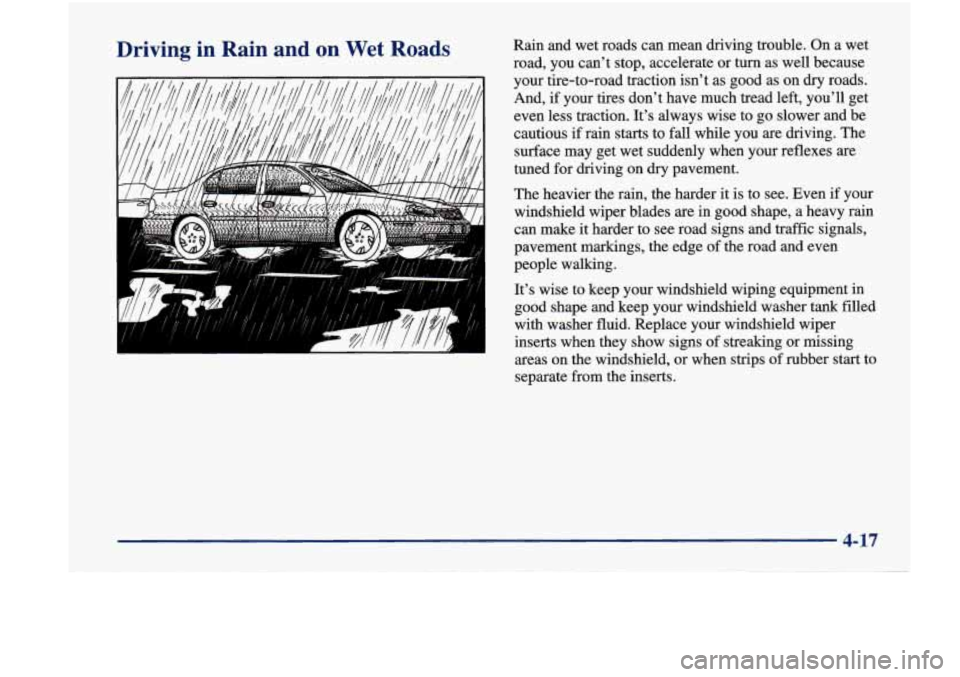
Driving in Rain and on Wet Roads
‘I
Rain and wet roads can mean driving trouble. On a wet
road, you can’t stop, accelerate or turn as well because
your tire-to-road traction isn’t as good as on dry roads.
And,
if your tires don’t have much tread left, you’ll get
even less traction. It’s always wise to go slower and be
cautious
if rain starts to fall while you are driving. The
surface may get wet suddenly when your reflexes are
tuned for driving on dry pavement.
The heavier the rain, the harder
it is to see. Even if your
windshield wiper blades are in good shape, a heavy rain
can make it harder to see road signs and traffic signals,
pavement markings, the edge of the road and even
people walking.
It’s wise to keep your windshield wiping equipment in
good shape and keep your windshield washer tank filled
with washer fluid. Replace your windshield wiper
inserts when they show signs of streaking or missing
areas on the windshield, or when
strips of rubber start to
separate from the inserts.
Page 168 of 356

City Driving Here are ways to increase your safety in city driving:
Know the best way to get to where you are
going. Get a city map and plan your trip into an
unknown part of the city just as you would for a
cross-country
trip.
Try to use the freeways that rim and crisscross most
large cities. You’ll save time and energy. (See the
next part, “Freeway Driving.”)
Treat a green light as a warning signal. A traffic
light is there because the corner is busy enough to
need it. When a light turns green, and just before you
start
to move, check both ways for vehicles that have
not cleared the intersection or may be running the
red light.
One of the biggest problems with city streets is the
amount of traffic on them. You’ll want to watch out for
what the other drivers are doing and pay attention
to
traffic signals.
4-20
Page 169 of 356

Freeway Driving
I’
Mile for mile, freeways (also called thruways, parkways, expressways, turnpikes or superhighways)
are the safest
of all roads. But they have their
own special rules.
The most important advice on freeway driving is: Keep
up with traffic and keep to the right. Drive at the same
speed most of the other drivers
are driving. Too-fast or
too-slow driving breaks a smooth traffic flow. Treat the
left lane on a freeway as a passing lane. At
the entrance, there is usually a ramp that leads to the
freeway.
If you have a clear view of the freeway as you
drive along the entrance ramp, you should begin to
check traffic. Try to determine where you expect to
blend with the flow. Try to merge into the gap at close to
the prevailing speed. Switch on your
turn signal, check
your mirrors and glance over your shoulder as often as
necessary. Try to blend smoothly with the traffic flow.
Once you are on the freeway, adjust your speed to the
posted limit or to the prevailing rate
if it’s slower. Stay
in the right lane unless you want to pass.
Before changing lanes, check your mirrors. Then use
your
turn signal.
Just before you leave the lane, glance quickly over
ypy
shoulder to make sure therecisn’t another vehicle in your
“blind” spot.
Once you are moving on the freeway, make certain you
allow a reasonable following distance. Expect to move
slightly slower at night.
When you want to leave the freeway, move to the proper
lane well in advance.
If you miss your exit, do not,
under any circumstances, stop and back up. Drive on to
the next exit.
The exit ramp can be curved, sometimes quite sharply.
4-21
Page 186 of 356
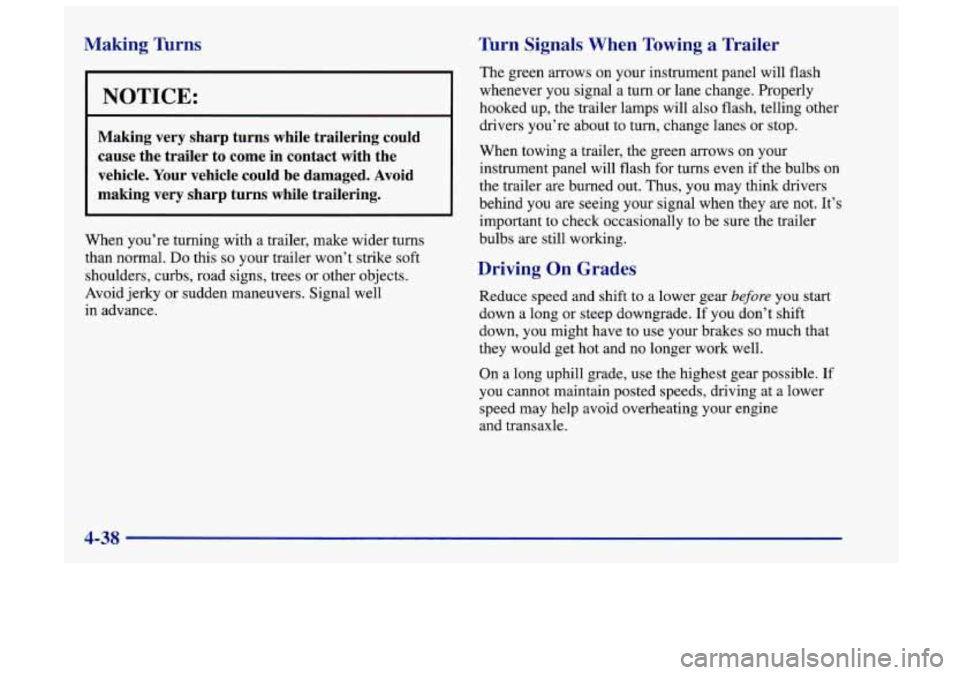
Making Turns
~ ~~ .-.
NOTICE:
Making very sharp turns while trailering could
cause
the trailer to come in contact with the
vehicle. Your vehicle could be damaged. Avoid
making very sharp turns while trailering.
When you’re turning with a trailer, make wider turns
than normal.
Do this so your trailer won’t strike soft
shoulders, curbs, road signs, trees or other objects.
Avoid jerky or sudden maneuvers. Signal well
in advance.
Turn Signals When Towing a Trailer
The green arrows on your instrument panel will flash
whenever
you signal a turn or lane change. Properly
hooked up, the trailer lamps will also flash, telling other
drivers you’re about to turn, change lanes or stop.
When towing a trailer, the green arrows on your instrument panel will flash for turns even if the bulbs on
the trailer
are burned out. Thus, you may think drivers
behind you are seeing your signal when they are not. It’s
important to check occasionally to be sure the trailer
bulbs are still working.
Driving On Grades
Reduce speed and shift to a lower gear before you start
down a long or steep downgrade.
If you don’t shift
down, you might have to use your brakes
so much that
they would get hot and no longer work well.
On a long uphill grade, use the highest gear possible. If
you cannot maintain posted speeds, driving at a lower speed may help avoid overheating your engine
and transaxle.
4-38
Page 190 of 356

Hazard Warning Flashers
Your hazard warning flashers let you warn others. They
also let police know you have a problem. Your front and
rear turn signal lamps will flash
on and off.
Move the switch to the right
to make your front and rear
turn signal lights flash
on
and off.
Your hazard warning flashers work no matter what
position your key is in, and even if the key isn’t in.
To turn off the flashers, move the switch to the left.
When the hazard warning flashers are
on, your turn
signals won’t work.
5-2
Page 262 of 356
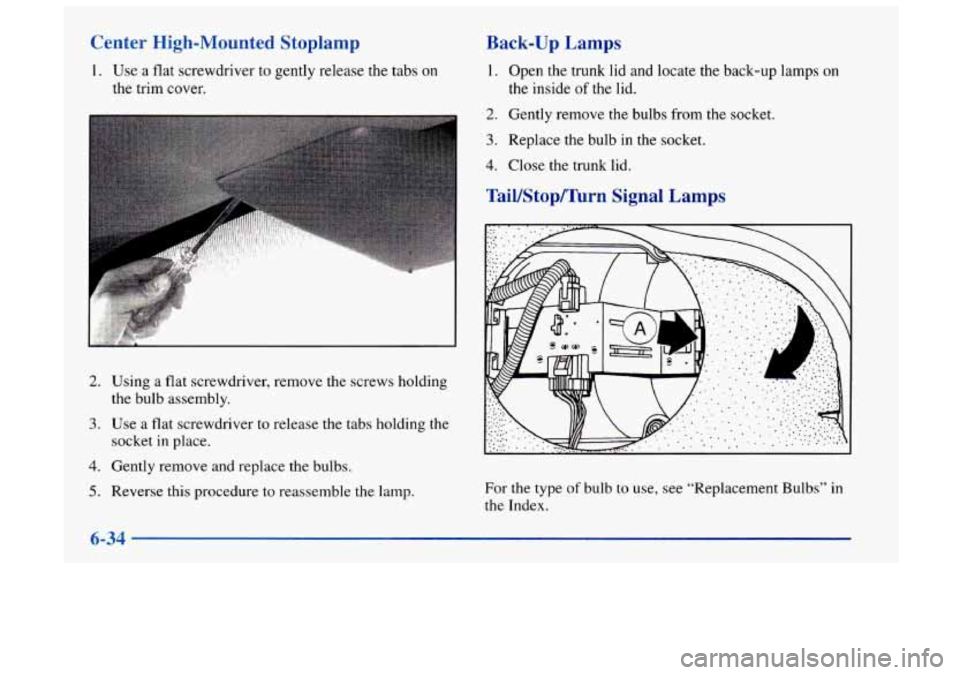
Center High-Mounted Stoplamp
1. Use a flat screwdriver to gently release the tabs on
the trim cover.
2. Using a flat screwdriver, remove the screws holding
the bulb assembly.
3. Use a flat screwdriver to release the tabs holding the
4. Gently remove and replace the bulbs.
socket
in place.
5. Reverse this procedure to reassemble the lamp.
Back-up Lamps
1. Open the trunk lid and locate the back-up lamps on
2. Gently remove the bulbs from the socket.
3. Replace the bulb in the socket.
4. Close the trunk lid.
the
inside
of the lid.
TaiYStop/Turn Signal Lamps
For the type of bulb to use, see “Replacement Bulbs” in
the Index.
6-34
Page 263 of 356
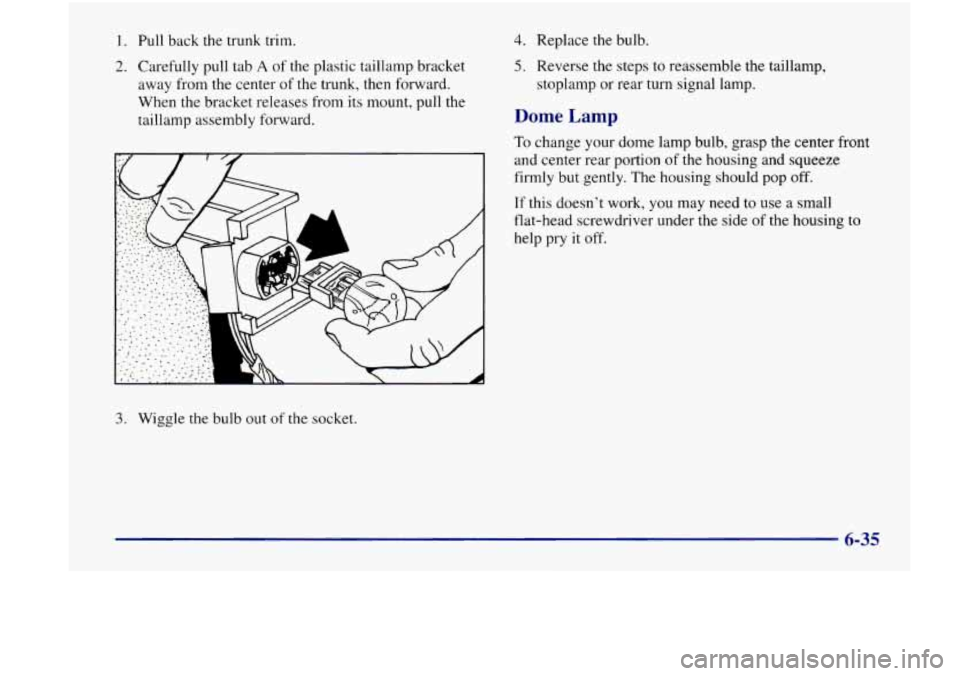
1. Pull back the trunk trim.
2. Carefully pull tab A of the plastic taillamp bracket
away from the center of the trunk, then forward.
When the bracket releases from its mount, pull the
taillamp assembly forward.
3. Wiggle the bulb out of the socket.
4. Replace the bulb.
5. Reverse the steps to reassemble the taillamp,
stoplamp or rear turn signal lamp.
Dome Lamp
To change your dome lamp bulb, grasp the center front
and center rear portion
of the housing and squeeze
firmly but gently.
The housing should pop off.
If this doesn’t work, you may need to use a small
flat-head screwdriver under the side
of the housing to
help pry it off.
6-35
Page 282 of 356
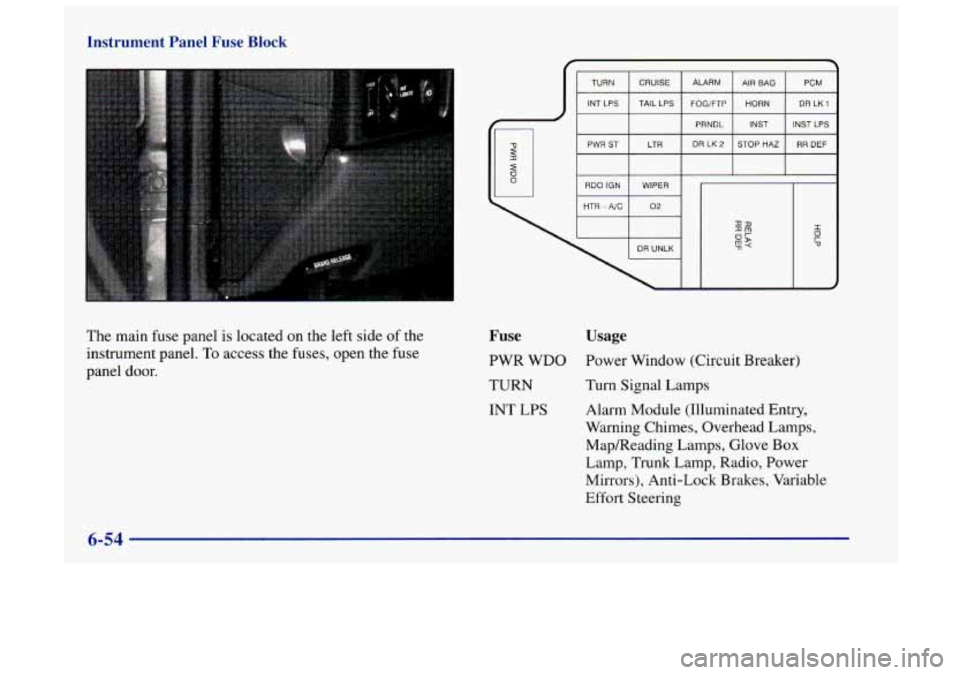
Instrument Panel Fuse Block
The main fuse panel is located on the left side of the
instrument panel. To access the fuses, open the fuse
panel door. Fuse
PWR WDO
TURN
INT LPS
Usage
Power Window (Circuit Breaker)
Turn Signal Lamps
Alarm Module (Illuminated Entry,
Warning Chimes, Overhead Lamps,
Mapmeading Lamps, Glove
Box
Lamp, Trunk Lamp, Radio, Power
Mirrors), Anti-Lock Brakes, Variable
Effort Steering
6-54
Page 351 of 356

Second Gear. Automatic Transaxle ................. 2-22
Service
........................................ 6-2
Bulletins. Ordering
............................ 8- 10
Manuals. Ordering
............................ 8- 10
Parts Identification Label
....................... 6-52
Publications. Ordering
......................... 8- 10
Work. Doing Your Own
......................... 6-2
Service and Appearance Care
...................... 6-1
Service and Owner Publications
................... 8- 10
Service Publications
............................. 8- 10
Servicing Your Air Bag-Equipped Oldsmobile
........ 1-27
Sheet Metal Damage
............................ 6-50
ShiftLever .................................... 2-18
Shifting
Automatic Transaxle
.......................... 2- 18
Into Park (P)
................................. 2-24
OutofPark
.................................. 2-26
Shoulder Belt Height Adjuster
..................... 1 - 15
Signaling Turns
................................ 2-30
Skidding
...................................... 4-14
Sound Equipment. Adding
........................ 3- 19
Spare Tire. Compact.
............................ 5-36
Specifications and Capacities
...................... 6-58
Specifications. Engine
........................... 6-58
Speech Impaired. Customer Assistance
............... 8-4
Speedometer
................................... 2-49
Stains. Cleaning
................................ 6-45
Starter Switch Check
............................ 7-32
Starting Your Engine .................. 2- 14.2-15. 2- 16
Steam
........................................ 5-15
Steering ...................................... 4-10
SRS ......................................... 1-21 In
Emergencies
............................... 4- 11
Power
...................................... 4-10
Tips
........................................ 4-10
Wheel. Tilt
.................................. 2-29
Storage Compartments
........................... 2-43
Storage. Vehicle
................................ 6-31
Stuck: In Sand. Mud. Ice or Snow
.................. 5-37
Sunvisors
.................................... 2-45
Sunglasses Storage .............................. 2-43
Supplemental Restraint System
.................... 1-21
Surge Tank. Coolant
............................. 5-17
Surge
Tank Pressure Cap ......................... 6-25
Symbols. Vehicle
.................................. v
Tachometer .................................. 2-50
Taillamp Bulb Replacement
....................... 6-34
TapePlayerCare
............................... 3-19
Theft
......................................... 2-11
Theft-Deterrent Feature. CD Player
................ 3-16
THEFTLOCK"
................................ 3-16
Thermostat
.................................... 6-25
Third Gear. Automatic Transaxle
................... 2-21
Tilt Steering Wheel ............................. 2-29
Time. Setting the
................................ 3-6
Tirechains
.................................... 6-43
TireLoading
................................... 4-31
Tire-Loading Information Label
.................... 4-31
Tires
......................................... 6-36
Alignment and Balance
........................ 6-42
BuyingNew
................................. 6-40
Chains
..................................... 6-43
9-9
Page 352 of 356
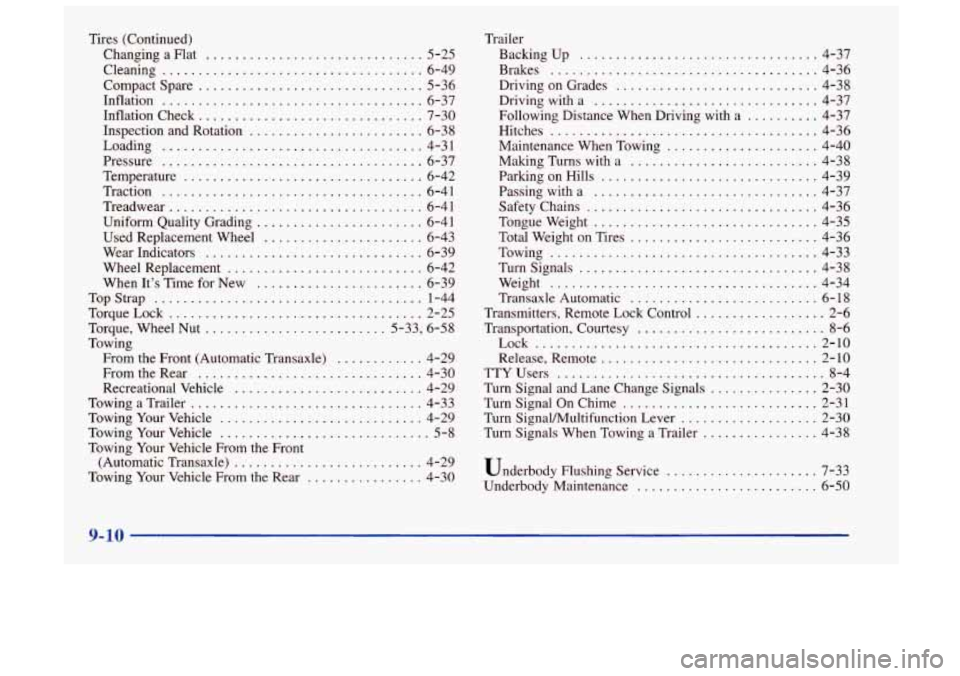
Tires (Continued)
Changing a Flat
.............................. 5-25
Compact Spare
............................... 5-36
Cleaning
.................................... 6-49
Inflation
.................................... 6-37
Inflation Check
............................... 7-30
Inspection and Rotation
........................ 6-38
Loading
.................................... 4-31
Pressure
.................................... 6-37
Temperature
................................. 6-42
Traction
.................................... 6-41
Treadwear
................................... 6-41
Uniform Quality Grading
....................... 6-41
Used Replacement Wheel
...................... 6-43
Wear Indicators
.............................. 6-39
Wheel Replacement
........................... 6-42
When It’s Time for New
....................... 6-39
TopStrap
..................................... 1-44
TorqueLock
................................... 2-25
Torque, Wheel Nut
......................... 5-33. 6-58
Towing
From the Front (Automatic Transaxle)
............ 4-29
From the Rear
............................... 4-30
Recreational Vehicle
.......................... 4-29
Towing a Trailer
................................ 4-33
Towing Your Vehicle
............................ 4-29
Towing Your Vehicle
............................. 5-8
Towing Your Vehicle From the Front
(Automatic Transaxle)
.......................... 4-29
Towing
Your Vehicle From the Rear ................ 4-30 Trailer
Backingup
................................. 4-37
Brakes
..................................... 4-36
Driving on Grades
............................ 4-38
Driving with a
............................... 4-37
Following Distance When Driving with a
.......... 4-37
Hitches
..................................... 4-36
Maintenance When Towing
..................... 4-40
Making Turns with a
.......................... 4-38
Parking on Hills
.............................. 4-39
Passing with a
............................... 4-37
Safety Chains
................................ 4-36
Tongueweight
............................... 4-35
Total Weight on Tires
.......................... 4-36
Towing
..................................... 4-33
Turnsignals
................................. 4-38
Weight
..................................... 4-34
Transaxle Automatic
.......................... 6-18
Transmitters. Remote Lock Control
.................. 2-6
Transportation. Courtesy
.......................... 8-6
Lock ....................................... 2-10
Release. Remote
.............................. 2-10
TTYUsers
..................................... 8-4
Turn Signal and Lane Change Signals
............... 2-30
Turn Signal On Chime
........................... 2-31
Turn Signalhlultifunction Lever
................... 2-30
Turn Signals When Towing a Trailer
................ 4-38
Underbody Flushing Service
..................... 7-33
Underbody Maintenance
......................... 6-50
9-10